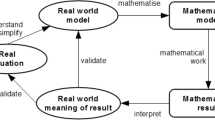Abstract
This work presents an integer programming formulation for a variant of the Class-Teacher Timetabling problem, which considers the satisfaction of teacher preferences and also the proper distribution of lessons throughout the week. The formulation contains a very large number of variables and is enhanced by cuts. Therefore, a cut and column generation algorithm to solve its linear relaxation is provided. The lower bounds obtained are very good, allowing us to prove the optimality of previously known solutions in three formerly open instances.
Similar content being viewed by others
References
Abramson, D. (1991). Constructing school timetables using simulated annealing: sequential and parallel algorithms. Management Science, 37, 98–113.
Abramson, D., & Abela, J. (1992). A parallel genetic algorithm for solving the school timetabling problem. In Proceedings of the 15th Australian computer science conference.
Alvarez-Valdés, R., Martin, G., & Tamarit, M. (1996). Constructing good solutions for the Spanish school timetabling problem. Journal of the Operational Research Society, 47, 1203–1215.
Avella, P., Boccia, M., & Vasilyev, I. (2008). A computational study of exact knapsack separation for the generalized assignment problem. Computational Optimization and Applications.
Avella, P., Boccia, M., & Vasilyev, I. (2009). Computational experience with general cutting planes for the set covering problem. Operations Research Letters, 37, 1.
Avella, P., & Vasil’ev, I. (2005). A computational study of a cutting plane algorithm for university course timetabling. Journal of Scheduling, 8, 497–514.
Balas, E. (1975). Facets of the knapsack polytope. Mathematical Programming.
Barnhart, C., Johnson, E. L., Nemhauser, G. L., Savelsbergh, M. W. P., & Vance, P. H. (1998). Branch-and-price: column generation for solving huge integer programs. Operations Research, 46, 316–329.
Boyd, E. A. (1992). Fenchel cutting planes for integer programming. Operations Research, 42, 53–64.
Boyd, E. A. (1994). Solving 0/1 integer programs with enumeration cutting planes. Annals of Operations Research, 50, 61–72.
Caldeira, J., & Agostinho, C. (1997). School timetabling using genetic search. In Practice and theory of automated timetabling. Toronto.
Colorni, A., Dorigo, M., & Maniezzo, V. (1998). Metaheuristics for high-school timetabling. Computational Optimization and Applications, 9(3), 277–298.
Costa, D. (1994). A tabu search algorithm for computing an operational timetable. European Journal of Operational Research, 76, 98–110.
Dantzig, G. B., & Wolfe, P. (1960). Decomposition principle for linear programs. Operations Research.
Daskalaki, S. (2004). An integer programming formulation for a case study in university timetabling. European Journal of Operational Research, 153, 117–135.
Di Stefano, C., & Tettamanzi, A. (2001). An evolutionary algorithm for solving the school time-tabling problem. In E. Boers et al. (Eds.), Applications of evolutionary computing. EvoWorkshops 2001 (pp. 452–462).
Drexl, A., & Salewski, F. (1997). Distribution requirements and compactness constraints in school timetabling. European Journal of Operational Research, 102(1), 193–214.
Eiselt, H. A., & Laporte, G. (1987). Combinatorial optimization problems with soft and hard requirements. Journal of the Operational Research Society, 38(9), 785–795.
Even, S., Itai, A., & Shamir, A. (1976). On the complexity of timetable and multicommodity flow problems. SIAM Journal of Computing, 5(4), 691–703.
Gotlieb, C. C. (1963). The construction of class-teacher timetables. In Proceeding IFIP congress 1962 (pp. 73–77). Amsterdam.
Hammer, P. L., Johnson, E. L., & Peled, U. N. (1975). Facets of regular 0-1 polytopes. Mathematical Programming, 8, 179–206.
Hertz, A. (1991). Tabu search for large scale timetabling problems. European Journal or Operational Research, 54, 39–47.
Ilog, S. A. (2006). ILOG CPLEX 10.0 user’s manual.
Mata, S. S. (1989). O problema do horário na escola do segundo grau: Modelagem e implementação. Master’s dissertation, Programa de Engenharia de Sistemas e Computação, COPPE, UFRJ.
Papoutsis, K., Valouxis, C., & Housos, E. (2003). A column generation approach for the timetabling problem of Greek high schools. Journal of the Operational Research Society, 54, 230–238.
Post, G., Ahmadi, S., Daskalaki, S., Kingston, J., Kyngas, J., Nurmi, K., Ranson, D., & Ruizenaar, H. (2008). An XML format for benchmarks in high school timetabling. In The 7th international conference for the practice and theory of automated timetabling.
Santos, H. G., Ochi, L. S., & Souza, M. J. F. (2005). A tabu search heuristic with efficient diversification strategies for the class/teacher timetabling problem. Journal of Experimental Algorithmics, 10.
Santos, H. G., Ochi, L. S., & Uchoa, E. (2006). Combining metaheuristics and integer programming on school timetabling problems (abstract). In Proceedings of the 19th international symposium on mathematical programming.
Schaerf, A. (1999). Local search techniques for large high school timetabling problems. IEEE Transactions on Systems, Man and Cybernetics Part A: Systems and Humans, 29(4), 368–377.
Souza, M. J. F. (2000). Programação de Horários em Escolas: Uma Aproximação por Metaheurísticas. PhD thesis, Programa de Engenharia de Sistemas e Computação, Universidade Federal do Rio de Janeiro - COPPE/UFRJ, Rio de Janeiro, Brasil.
Souza, M. J. F., Ochi, L. S., & Maculan, N. (2004). Metaheuristics: computer decision-making, chapter A GRASP-Tabu Search Algorithm for solving School Timetabling Problems (pp. 659–672). Kluwer.
Wolsey, L. A. (1975). Faces for a linear inequality in 0-1 variables. Mathematical Programming.
Author information
Authors and Affiliations
Corresponding author
Rights and permissions
About this article
Cite this article
Santos, H.G., Uchoa, E., Ochi, L.S. et al. Strong bounds with cut and column generation for class-teacher timetabling. Ann Oper Res 194, 399–412 (2012). https://doi.org/10.1007/s10479-010-0709-y
Published:
Issue Date:
DOI: https://doi.org/10.1007/s10479-010-0709-y




